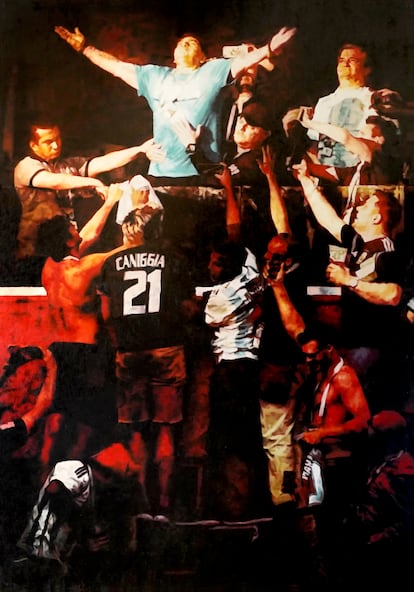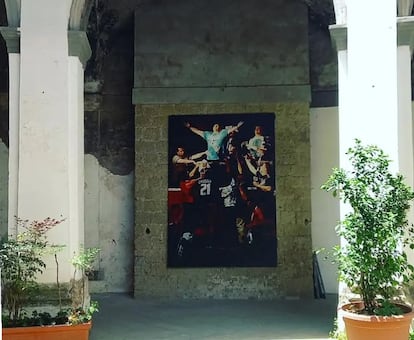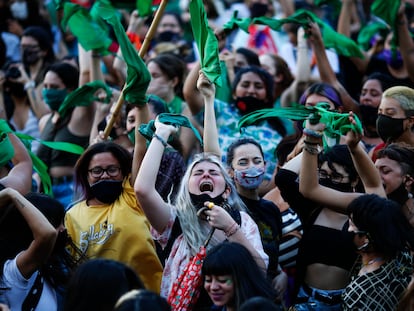Diego Maradona’s secret chapel in Naples
The cloister of the church of Santa Maria della Sanità houses a curious baroque-inspired painting in which the Argentine soccer star appears with his arms raised toward the heavens

The faded streets of Naples are full of religious chapels and memories of Diego Armando Maradona. Every 100 meters, there’s a virgin and two images of the Argentine soccer star, the myth that allowed the city to take revenge on its nemesis, northern Italy. But there is a hidden and little-known corner that unites religion and soccer, consecrating the divine essence of the fallen soccer genius (Maradona died in 2020 at the age of 60). His image appears in a place as sacred as the cloister of the Basilica of Santa Maria della Sanità church (better known as San Vincenzo, after St. Vincent Ferrer). There, above the San Gaudioso catacombs, hangs a curious Baroque-inspired painting in which Pelusa (one of Maradona’s nicknames, “the fuzz”) is depicted with his arms raised toward heaven, like a messiah. Indeed, that is what he represents for the people of Naples.
“We liked [the idea of] putting it there because the spirit of the work is situated on the border between what is religious and what is treated as such,” the 44-year-old artist Elvis Spadoni who painted it explains to this newspaper. He avoided displaying his painting inside a church, he notes, but the cloister belongs to the parish, and he had to negotiate it with the priest beforehand.
This Tuesday morning, the curiosity of this oil painting — which is 1.90 meters (about 6 feet) wide by 2.70 meters (just shy of 9 feet) high — was completed by several elderly locals, who come every day to the base of the artwork just to sit on a plastic chair and watch the day go by. “Maradona was a miracle for us. He was our revenge against the north,” 73-year-old Giuseppe says with a smile. He also complained that Italian public television does not show the Napoli-Real Madrid match at night, so he must go to a bar to watch it.
As an employee at the catacombs’ tourist office explains, not many tourists or fans of the former player travel there and the painting has not been overly promoted, either. A few steps from the painting, the church’s nativity scene has a figurine of Maradona kicking a pumpkin. Everything revolves around Diego Maradona.

Spadoni, an artist who makes works of sacred art, got the idea for the painting, titled Diego, when he saw an image of the soccer legend celebrating an Argentine goal in the 2018 World Cup. The goal took place in Argentina’s 2-1 win over Nigeria, which secured the former a spot in the round of 16. That afternoon, Maradona experienced the gamut of emotional states, always in excessive fashion: he lifted his shirt and showed his belly, fell asleep in his box, gave combs to the crowd and struck the pose that Spadoni immortalized.
“The photo looked like a baroque painting, so I transformed it as if it were an altarpiece with the scene of a saint looking at the sky and the divine light, surrounded by his devotees. To achieve that, I used colors similar to the palette of the Baroque period,” the artist explains, adding that the work also has “a playful point.” “Once [it was] painted, I wanted to take [the painting of Maradona] to Naples, because he is considered the patron saint there. The Sanità neighborhood was suggested to me, because of the priest Antonio Loffredo and the cooperative linked to the catacombs, which is very active in the cultural field. I wrote to Father Antonio, and he loved the idea of exhibiting the painting,” says Spadoni.
In the past five months, the cloister of this 17th century church, which is rich in baroque altarpieces, has also become a place to venerate the city’s contemporary god. Just a 20-minute walk from the Quartieri Spagnoli [Spanish Quarter] neighborhood, which is overcrowded with tourists, stands Diego Armando Maradona’s secret chapel.
Sign up for our weekly newsletter to get more English-language news coverage from EL PAÍS USA Edition
Tu suscripción se está usando en otro dispositivo
¿Quieres añadir otro usuario a tu suscripción?
Si continúas leyendo en este dispositivo, no se podrá leer en el otro.
FlechaTu suscripción se está usando en otro dispositivo y solo puedes acceder a EL PAÍS desde un dispositivo a la vez.
Si quieres compartir tu cuenta, cambia tu suscripción a la modalidad Premium, así podrás añadir otro usuario. Cada uno accederá con su propia cuenta de email, lo que os permitirá personalizar vuestra experiencia en EL PAÍS.
¿Tienes una suscripción de empresa? Accede aquí para contratar más cuentas.
En el caso de no saber quién está usando tu cuenta, te recomendamos cambiar tu contraseña aquí.
Si decides continuar compartiendo tu cuenta, este mensaje se mostrará en tu dispositivo y en el de la otra persona que está usando tu cuenta de forma indefinida, afectando a tu experiencia de lectura. Puedes consultar aquí los términos y condiciones de la suscripción digital.
More information
Archived In
Últimas noticias
Most viewed
- Reinhard Genzel, Nobel laureate in physics: ‘One-minute videos will never give you the truth’
- Oona Chaplin: ‘I told James Cameron that I was living in a treehouse and starting a permaculture project with a friend’
- Pablo Escobar’s hippos: A serious environmental problem, 40 years on
- Why we lost the habit of sleeping in two segments and how that changed our sense of time
- The fall of a prolific science journal exposes the billion-dollar profits of scientific publishing










































